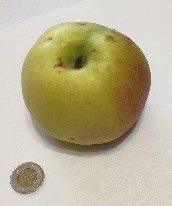Postcard Memories is a series of historic views, stories, and photos of Bradford and the area, a trip down memory lane on a Saturday morning.
Submitted by Bradford resident and "gleaner" Albert Wierenga
Planting trees must be one of the greatest affirmations of belief in the future. It is forward-looking. As my grandfather stated and demonstrated, “We plant fruit trees today so that the next generation can enjoy them”.
One of my great pleasures is walking anywhere within five kilometres of Bradford’s core and encountering so many visible proofs of pioneering foresight. Fruit trees are spectacular when they are in full spring bloom and are generous (on roadside allowances) with their organically grown ripened produce in the fall. As an experienced “gleaner” (an old, biblical term), I take full advantage of collecting this fruit and sharing these ‘found’ treasures, made into sauces or dried chips, with family and neighbours.
The pioneers who settled our greater Bradford area planted many fruit trees. It was one of the first things they used to do once they received and started clearing their land. They planted many different apple species. They chose many varieties because they did not know which apple trees were the most suitable for our climate and soils (just like grapes, apples also have a ‘terroir’). By planting many apple varieties, they raised the odds of producing a good apple crop every year.
When we had our house built in the southern end of Bradford, the bulldozers were flattening everything that had grown on the stony and marginal soils of what is reputed to be “the old Turner farm”. We asked the builders, before they started our house, not to bulldoze the old apple trees on the property’s edge. They agreed. For the last 30 years, we have enjoyed the fruit of these very old apple trees.
Three interesting species that I have ‘found’ while walking the roads are:
- An apple called 'Discovery'. It was first introduced to the market by the Suffolk nurseryman Jack Matthews. Around 1949, George Dummer, a fruit farm worker from Essex, raised several apple seedlings and he decided to transplant the best of them in his front garden. By error, this young tree was left unplanted and exposed to frost, wrapped only in sacking, for several months. The tree survived and later came to the attention of Matthews, who took grafts and developed it for release in 1962. The apple has a unique appearance and makes great-tasting red applesauce
- A much older, large apple, called Antonovka, has been popular in Russia and Poland for a long time. It was developed by the pioneer Russian naturalist and plant breeder Ivan V. Michurin at his experimental orchard. The apple was introduced to the public in 1888. Many nurseries use Antonovka rootstocks since they impart a degree of winter-hardiness to the grafted varieties. It was brought as a seedling to Bradford by a Russian émigré farmer who planted it in the Holland Marsh before the Second World War. The apple makes great apple chips after a night in the dehydrator.
- Not being an apple expert, even with the Internet as a resource, it is sometimes difficult to identify an apple species. This one with tough skin and having survived several frosts over the last weeks were confusing. When peeled, it browned my fingers horribly. The apple pieces floated when cooked! The apple sauce was coarse but very sweet. It makes excellent pioneer “apple leather”. An expert, who was consulted, defined it as a Mac. The many frosts it was exposed to had altered its structural appearance.
Interestingly Mac apples have quite a Canadian story. In 1811, John McIntosh was clearing some land in Quebec when he saw some seedlings. “Apples”, he thought, so instead of clearing them also, he transplanted a dozen in his garden. By the following year, all but one had died. He nursed that one to maturity. Every McIntosh apple that has ever been eaten, put into a pie, into juice, or cider is a direct descendant of that little seedling that mysteriously appeared in the Canadian woods and tenaciously clung to life. Only by grafting a variety onto the trunk of another tree can an apple variety be maintained. The orphan that McIntosh found in the bush that day, likely grown from seeds of an apple core tossed on the ground by a passerby, was naturally cross-pollinated, an offspring of unknown ancestors.
The MacIntosh is a gift from nature and thanks to the pioneers they were planted all over Bradford West Gwillimbury. Keep that thought in mind when you see an open piece of ground. Think future.



